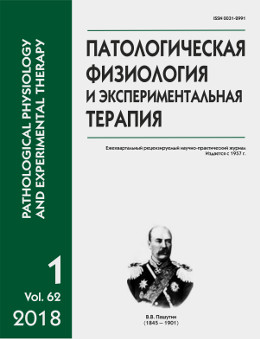Assessment of the influence of physical activity by a modified method on metabolic processes in students
DOI:
https://doi.org/10.25557/0031-2991.2018.01.65-70Keywords:
ashtanga yoga, laser correlation spectroscopy, psychomotor parameters, physical exerciseAbstract
Introduction of new methods of athletic training and physical education requires obligatory medical support. The optimal approach is the technique that allows achieving intensive progress of sports mastery and physical fitness under conditions of greatest balance of individual indicators and integrated level of functional systems that determine the adaptive reserves of the body and fully meet the criteria of healthy population of the same age and gender. Informative diagnostics of functional adequacy of physical exercise can be achieved via simultaneous multivariate testing of systems determining the integral body homeostasis. Goal. Evaluation of changes in prevailing direction of metabolic processes during physical exercise by the original methodology characterized by intensive physical exercise. Methods. Urine samples from 179 first-second-year students aged 17.5±1.5 years (initially), 126 girls and 53 boys, were analyzed by laser correlation spectroscopy. To study parameters of psychomotor regulation (UPMD-01-INTOKS complex) and their correlations with predominant direction of metabolic processes 600 schoolchildren of both sexes aged 15-16 years without documented chronic diseases (I health group) were tested. Results. Baseline parameters were measured to characterize the prevailing directions of metabolic shifts in the examined group before the start of training by the developed technique. Predominant contribution of catabolic and anabolic shifts (49% and 41%, respectively) and minor contribution of mixed (7%) and normal (3%) shifts were found. After 1-year training by the developed technique, the number of students with anabolic type of metabolic processes significantly decreased. As anabolic shifts decrease and catabolic shifts increase, the frequencies of the longest movement cycles of both extensors and flexors, the most erroneous corrections, and the most stressed states of flexor-extensor muscles decreased. This pattern was revealed for all 5 independent criteria and in strict accordance with the increase of catabolic and decrease in anabolic shifts. Conclusion. The revealed correlation between the directions of metabolic processes and some psychomotor parameters suggests that this technique will have a positive impact on the health of students.Downloads
Published
2018-01-25
Issue
Section
Original research
How to Cite
[1]
2018. Assessment of the influence of physical activity by a modified method on metabolic processes in students. Patologicheskaya Fiziologiya i Eksperimental’naya Terapiya (Pathological physiology and experimental therapy). 62, 1 (Jan. 2018), 65–70. DOI:https://doi.org/10.25557/0031-2991.2018.01.65-70.






